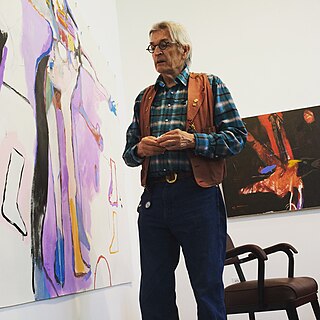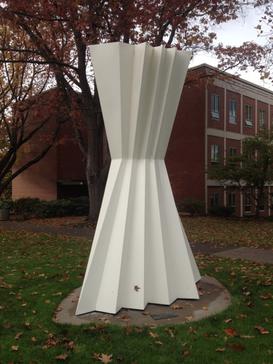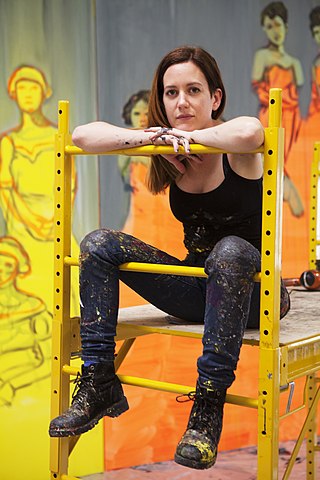Olga Volchkova is a Russian-born artist currently resident in Eugene, Oregon.

Carl A. Morris was an American painter, born in Yorba Linda, California. Morris studied at the Chicago Art Institute and in Paris and Vienna. He opened the Spokane Art Center through the Federal Art Project during the Great Depression. Morris met his wife, sculptor Hilda Grossman, when he recruited her as a teacher for the center. Moving to Seattle in 1940, they met Mark Tobey and became lifelong friends.

Jordan Schnitzer Museum of Art (JSMA) is an art museum located on the campus of the University of Oregon in Eugene, Oregon. The original building was designed by Ellis F. Lawrence as part of his "main university quadrangle," now known as the Memorial Quadrangle. Its first Director, Asian art collector, and female museum specialist Gertrude Bass Warner, also influenced the building's design, particularly its innovative climate control measures. The museum is accredited by the American Alliance of Museums.

Maude Irvine Kerns was an American artist and art educator, known for her avant-garde paintings. Her works were exhibited at the Guggenheim Museum, National Gallery of Art, and the Salon des Réalités Nouvelles, and earned Kerns considerable notoriety among the abstract art movement in New York. She later taught art at the University of Oregon as well as at high schools in Corvallis and Seattle, Washington before her death in 1965.
Tom Cramer is an American artist working in Portland, Oregon noted for his intricately carved and painted wood reliefs and ubiquity throughout the city of Portland. Often called the unofficial Artist Laureate of Portland, Cramer is one of the most visible and successful artists in the city. The influences on his work are both organic and technological. He is widely collected and is in many prominent west coast museum and private collections. He is in the permanent collections of the Portland Art Museum in Portland Oregon, the Halle Ford Museum in Salem Oregon, the Jordan Schnitzer Museum in Eugene, Oregon, the Boise Art Museum in Idaho.

Richard Elmer "Rick" Bartow was a Native American artist and a member of the Mad River band of the Wiyot Tribe, who are indigenous to Humboldt County, California. He primarily created pastel, graphite, and mixed media drawings, wood sculpture, acrylic paintings, drypoint etchings, monotypes, and a small number of ceramic works.

Robert Coe was an early English settler, public official, and a founder of five towns in Connecticut and New York: Wethersfield, Stamford, Hempstead, Elmhurst, and Jamaica. Coe took passage from England to the Americas in 1634 during the Puritan migration to New England. He is considered the founder of the Coe family in America and was the primary progenitor in New England of Coes. He has many notable descendants, including the 43rd President of the United States, George W. Bush, British Prime Minister Winston Churchill, the screenwriter of Gone with the Wind, Sidney Howard, and the namesake of the largest state park in Northern California, Henry W. Coe State Park.
Arlene Schnitzer was an American arts patron and philanthropist. She was the founder and director of the Fountain Gallery, established in Portland to showcase artists in the Pacific Northwest. She is the namesake of the Arlene Schnitzer Concert Hall, a performing arts center in Portland, Oregon.

Lady is an outdoor sculpture by Jan Zach, installed outside the Jordan Schnitzer Museum of Art, between Prince Lucien Campbell Hall and Condon Hall, on the University of Oregon campus in Eugene, Oregon, in the United States. The 14-foot (4.3 m) painted steel sculpture was donated to the museum in 2014. It was commissioned by Inacio Peixoto, in memory of his wife, and marked Zach's final work. The sculpture was a work in progress when Zach died in 1986, but his former student Jerry Harpster was able to fabricate Zach's original vision.

Indian Maiden and Fawn is a 1917–1924 sculpture by Alexander Phimister Proctor.

The Falconer is a bronze sculpture by James Lee Hansen. Dates for the abstract piece range from the 1960s to 1973.

LaVerne Erickson Krause (1924–1987) was an American artist. She founded the University of Oregon printmaking program and taught there for twenty years, creating more than ten thousand paintings and prints in her lifetime. An advocate for artists' economic and working conditions, she was instrumental in founding the Oregon chapter of the Artists Equity Association and served as president of the national Artists Equity. She is "recognized for her outstanding contributions as an educator, studio artist, and arts activist".
Eunice Lulu Parsons, also known as Eunice Jensen Parsons, was an American modernist artist known for her collages. Parsons was born in Loma, Colorado, and lived in Portland, Oregon. She studied at the School of the Art Institute of Chicago and the Portland Museum Art School, where she also worked as a teacher for over 20 years.

Amanda Viola Snyder, née Tester, was a contemporary American artist from Portland, Oregon. She produced hundreds of drawings, paintings and woodcuts, and held 32 solo exhibitions.

Reflections of a Summer Day is an outdoor 1974 painted steel sculpture by Duane Loppnow, installed near the entrance to the Jordan Schnitzer Museum of Art on the University of Oregon campus in Eugene, Oregon, in the United States. The sculpture was given to the University of Oregon by the sculptor, a graduate of the university.
Gertrude Bass Warner was an American twentieth-century art collector, with particular interests in Asian art, religious artifacts, daily-life textiles, ceramics, paintings, and photographs. She lived, traveled, and collected art in East Asia from 1904 to 1938. In 1922 she became the curator for life and first director of the University of Oregon Museum of Art at the University of Oregon, helping to design the historic building with famed architect Ellis F. Lawrence. She had the museum built to house the collection of more than 3,700 works of art, the Murray Warner Collection of Oriental Art, named after her late husband, Murray Warner. She donated the collection to the university in 1933. She traveled throughout China, Japan, Korea, and Russia purchasing works of art and artifacts, taking photographs, and writing extensive field notes. She visited thousands of cultural sites and studied Shinto, Buddhism, and Chinese and Japanese etiquette, and the human experience, and became an innovator in the promotion of Asian art and culture appreciation, Asian studies, and multiculturalism. She is considered a female pioneer of museum studies.
Anne Kutka, aka Anne Kutka McCosh was a Northwest American artist. She has several works in the Jordan Schnitzer Museum of Art collection including The Challenger, and three in the Portland Art Museum including an untitled oil painting referred to as House on Cliff. Exhibitions of her works have occurred in the Metropolitan Museum of Art, Seattle Art Museum, and the Art Institute of Chicago.

Claire Tabouret is a French artist based in Los Angeles, California, United States. She works with figurative subject matter, using loose expressive brushstrokes in a broad palette, mimicking both artificial and natural hues.
David John McCosh was a Northwest American artist and art instructor. The Jordan Schnitzer Museum of Art has over 170 of his works in their permanent collection.
Ka'ila Farrell-Smith is a Native American Modoc/Klamath visual artist, environmental activist, and writer.












